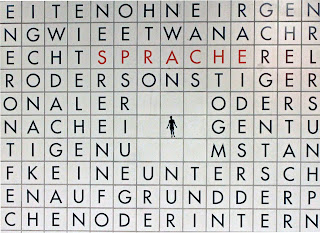Owning a car sucks. I mean, really: You've got to pay for gas, insurance, oil changes, tires, maintenance. You've got to worry about crashing it. You've got to fret about driving in adverse conditions (traffic). So, it was with great cathartic relief that we sold our car, along with most of our other possessions, when we moved from rural Colorado to Berlin a couple of years ago. After we got here, we had a brief moment during which we thought we needed to buy a car. It passed.
No one
needs to own a car in Berlin. A thick and complex
public transportation net stretches from one end of the city to the other, so that no matter where you might be, a U-Bahn, S-Bahn, tram or bus is no more than a few blocks and a 10 minute wait away. And once you're in the net, you can get within a few blocks of wherever it is you might want to go. Add to that the fact that Berlin is bike-friendly, with plenty of bike paths and lanes and its lack of topography (making a ride from one side of the city to the other, even on an old Communist-era one-speed, a rather quick and not-too-grueling endeavor), and you've got a city in which cars are superfluous.
Since I don't like cars, I like Berlin. But the public transportation is more than just a car substitute. It's a great medium through which one can see and experience a dynamic, diverse and rather spread out city. At least
Joseph Roth thought so. A newspaper columnist in 1920s Berlin, he was one of the greatest chroniclers of the city. In his 1922 column, "The Ride Past the Houses," Roth wrote:
The S-Bahn line goes right past the houses, affording its passengers many curious and interesting sights... Sometimes a ride on the S-Bahn is more instructive than a voyage to distant lands. Experienced travelers will confirm that it is sufficient to see a single lilac shrub in a dusty city courtyard to understand the deep sadness of all the hidden lilac trees anywhere in the world.
Which is why I return from a ride on the S-Bahn full of many sad and beautiful impressions, and when I navigate a little bit of the city, I feel as proud as if I had circumnavigated the globe.
Of course, that was nearly a century ago. Now, with trains, trams and buses going everywhere, it's even more true. Aside from walking, riding buses and trains is the best way to see Berlin, and it's a lot quicker. If you want the typical tourist sights, just hop on Bus 100 at Alexanderplatz, climb up to the top-floor (it's a double-decker, just like the 15 Euro-a-pop sightseeing buses) and relax as you glide past the Brandenburg Gate, the Siegessäule, the Reichstag and Bellevue Palace, embassy alley. And the round trip costs just 2,30 Euro, or about $3; spend four Euros more, and you can spend the whole day riding buses and rails, through every part of the city imaginable. I've been known to do the entire Ring Bahn loop, just to see some of the city's fringe, a stunning view of the Spree near Ostkreuz and a good glimpse of wild street art and abandoned industrial areas.
Yes, and there are the people, too. Berlin trains are nowhere near as animated as, say, those in Naples -- Germans are a bit more
zurückhaltend, or restrained. But the trains are packed with humanity of all sorts -- rich and poor, workers in suits and coveralls, old and young. They chat, they stare out at the landscape slipping by, old German ladies lecture parents about their kids' behavior and they read. Yes, read, not stare transfixed at electronic devices. Mostly they read newspapers -- I credit the public transportation system for the success of Germany's print periodicals -- and a few magazines. Also books. It's not crazy to see, in one day, different people reading Walter Benjamin, Hannah Arendt, Adorno and The Girl With the Dragon Tattoo.
With all those people in small spaces, it's inevitable that love will eventually blossom. Which is why the BVG, which operates the transportation net, has its own "missed connections" page on its website. Make some meaningful eye contact with someone on the U-1 but were too shy to introduce yourself? Just go to
Meine Augenblicke page and post an ad. Here's a rough translation of one from today:
I found you beautiful.
 M41
M41
Date: 10/01/2012 16:00
Posted: 10/01/2012 22:15
From: slacker
Mini golfing? Really? So sweet. The point is, riding the Berlin Bahns isn't just a commute, it's an adventure. It's life. And it's a huge part of life that most of the United States is simply missing out on. Instead, we doom ourselves to sitting for hours in our sealed little steel bubbles, in traffic on some placeless freeway between the suburbs and the strip mall. Too bad.
I wanted to capture the experience of Berlin's public transportation, so I made this video. It's a bit long, and for that I apologize. But just think of it as a 12 minute meditative break (the music, after you get through the intro, facilitates deep thought). Every shot is either of, or from, Berlin's public transportation. Most are from trains or buses, with a bit from trams. The Hauptbahnhof -- a grand, modern station full of shiny steel and glass -- plays a leading role. The gritty Warschaustrasse station in the east gets a small part, as do a few passengers and even a woman plucking her eyebrows in her apartment window, directly across from the S-Bahn station.




















